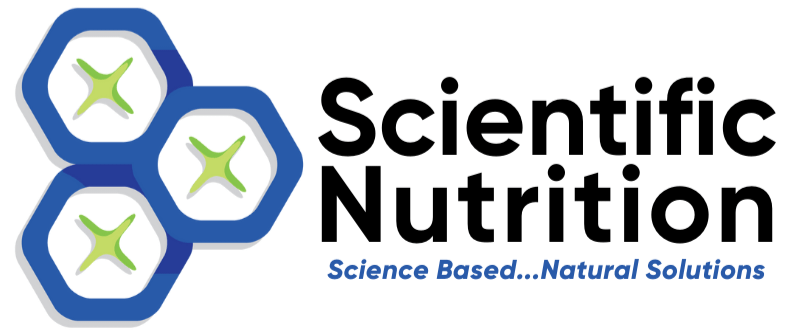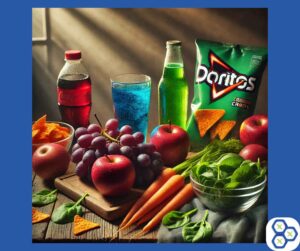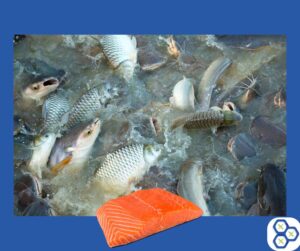Struggling with weight loss? Discover the hidden dangers in your food
Obesogens may be why you are struggling with weight loss. The problem could be what is IN your food. The dangers of obesogenic foods and how to detox them are becoming frequent questions. Identifying, removing, and detoxifying them is becoming more important daily. Let’s dig into these foods, products, and exposures you need to avoid.
Obesogens – who found them?
The word “obesogen” was first coined in 2006 by researcher Bruce Blumberg to describe a chemical that can promote weight gain, fat storage, and obesity. Blumberg was studying how certain chemicals can disrupt the normal functioning of our hormones. These chemicals are found in a variety of everyday products, such as food, cosmetics, and cleaning supplies.
In this blog, we will discuss obesogens, their effects on our health, and how to avoid them.
What are obesogens?
Obesogens are defined as “environmental chemicals that promote obesity”. Obesogens are any substances—usually synthetic chemicals—that can cause weight gain. Synthetic obesogens work by interfering with hormones and the hormones that regulate appetite, metabolism, and fat storage.
These disruptive agents shift your body’s energy from burning to storing calories. Eventually, there is an alteration in your metabolic set point for calories and fat storage. Instead of your thyroid and other glands directing your body weight, these toxic agents are behind the wheel steering your body to store adipose fat. Some may even experience insatiable hunger as the biochemistry changes.
Natural ways to avoid obesogens
Common obesogens include bisphenol A (BPA), propylparaben, phthalates, pesticides, and synthetic hormones such as testosterone and progesterone. In general, these chemicals can be found in food, cosmetics, personal care products, furniture, and cleaning supplies.
Obesogens can also be found in packaged and processed foods, foods containing additives, chemically sprayed fruits and vegetables, water supplies, air pollution, car exhaust, and cigarette smoke.
Two other chemicals to avoid would be tributyltin (TBT) found in seafood and shellfish, fungicides for paper mills, polyvinyl chloride found in plastics, house dust, and industrial water systems. This toxin was even found in fat accumulation in the livers and testis of babies in vitro. Another chemical triphenyltin (TPT) is typically found in fungicides on high-value food crops.
Can the link between obesogens cause weight gain and obesity?
When people are exposed to obesogens, their endocrine system is disrupted and certain hormones, such as insulin and leptin, are thrown out of balance. As a result, the body doesn’t respond properly to signals regulating appetite and metabolism, leading to weight gain.
In addition to disrupting hormones, obesogens can alter the way fat cells store and use energy, causing them to become less efficient at breaking down and burning fat. This can contribute to the buildup of fat and is a direct link to obesity.
For those who are overweight, eating obesogenic food and being exposed to obesogenic chemicals can make it much harder to lose weight. It will cause an increase in fat storage. These substances can make it difficult for the body to regulate hunger hormones, causing cravings and increased appetite.
Finally, they can also increase cravings for unhealthy foods and decrease activity levels, making it easier to gain weight.
Types of Obesogens list
There are four major types of obesogens:
Endocrine-disrupting chemicals
The Endocrine Society defines an endocrine-disrupting chemical (EDC) as “An exogenous chemical, or a mixture of chemicals, that can interfere with any aspect of hormone action”. These chemicals are intentional or unintentional additives to food and other common household products, including flame retardants, plasticizers, and synthetic hormones. They can interfere with hormones in the body, disrupting the homeostasis of appetite, metabolism, fat storage, and more.
Energy-dense foods
These are high-calorie, nutrient-poor foods, such as refined grains, processed meats or foods, packaged snacks, sugary drinks, and sweets. These foods are typically low in essential nutrients and high in calories and fat.
Dietary Deficiencies
These are low nutrient levels in the diet that can lead to chronic hunger and cravings for energy-dense foods. Deficiencies in micronutrients, such as iron and zinc, can lead to overeating.
Environmental obesogens
These are obesogens found in the environment, such as pesticides, air pollution, cigarette smoke, and car exhaust. They can cause toxic stress and disrupt endocrine functions, resulting in insulin resistance and weight gain. In fact, pesticides accumulate in fat and mimic estrogen hormones at the tiny parts per trillion (ppt) level.
The dangers and effects of obesogens on weight gain
Obesogens can have many dangerous health effects both physical and mental. They may also affect cognitive and behavioral development in children and adolescents, leading to issues such as attention deficit hyperactivity disorder (ADHD) and autism spectrum disorder (ASD).
Health risks associated with obesogens
Not only is obesity a major health concern, but the chemicals and energy-dense foods can cause serious issues in the body. For example, exposure to obesogens can increase the risk of type 2 diabetes, neurodegenerative disease, heart disease, and certain types of cancer. Nearly 40% of all cancer diagnoses are in overweight or obese people in the United States so it needs to be a priority to cut these chemicals out of the diet.
In addition, endocrine-disrupting chemicals can interfere with hormones, leading to metabolic disorders. This could be a slow thyroid (hypothyroidism) or adrenal burnout syndrome. Sexual reproductive hormones may also have negative effects from these chemical exposures.
Moreover, these obesogens can increase inflammation in the body, leading to an increased risk of chronic diseases. In addition, people with exposure to environmental contamination can be more prone to stress-related weight gain.
How to detox from obesogens?
Detoxification is an important step in reducing and eliminating the effects of obesogens on our bodies. This process may involve lifestyle changes or it may involve dietary changes to limit eating obesogenic foods.
Luckily, there are some strategies that you can use to reduce your exposure and 7 ways to detoxify your body of obesogens:
- Reduce your intake of processed foods containing artificial additives, preservatives, food coloring, and added sugars. These are some of the most common sources of obesogenic chemicals.
- Increase your intake of organic non-GMO whole foods and fresh produce. Fresh foods are typically better sources of micronutrients, which can help support the detoxification process. Incorporating herbs and spices mentioned below into the diet can also help to flush out toxins.
- Drink plenty of spring water with minerals. Staying hydrated helps your body flush toxins and can assist in the detoxification process.
- Reduce stress. Stress can increase cortisol levels, leading to the cycle of overeating, cravings, and weight gain.
- Exercise regularly. Exercise helps your body eliminate toxins through sweating and breathing. It also helps support a healthy metabolism and can reduce stress.
- Get enough sleep. Not just 6 hours but 8-10 hours of quality sleep which helps the body to reset and repair, helping support a healthy detoxification process.
- The products we use absorb through the skin and may increase the risk of obesity. Cosmetics, lotions, moisturizers, and shampoos, may contain obesogens so use healthy versions to eliminate constant contamination. They have a strong link to abnormal weight gain and negative health implications including cancers.
It is important to be aware of the potential sources of obesogens and take steps to reduce your exposure to them. Eating a healthy diet, avoiding plastic packaging, and using natural, organic cosmetics can help reduce your risk of exposure to obesogenic chemicals.
Obesogens – how to remove them at a deeper level?
Did you know that animal and human studies show that if one is born with poor prenatal nutrition they will have an increased risk for diseases such as obesity throughout their life and even in subsequent generations?!
This would help explain the obesity pandemic our pediatric population is suffering from. The fact that in 2006, an incredible 18.5% of American children aged 2 to 19 were obese (≥95th percentile on CDC growth charts), and 32% were overweight (≥85th percentile) shows the sad predisposition.
In conclusion, detoxifying from biochemical agents is an important step in managing our overall health and wellness. We can reduce and eliminate the effects of obesogens.
Hair Analysis and Obesogens
If you feel you have had exposure to a large number of obesogens, you may want to seek my professional help along with my assistance guided by your Hair Mineral Analysis.
We can tailor your dietary patterns, create personalized detoxification regimens, and rebuild your nutritional deficiencies with targeted supplementation. Obesity has genetic, epigenetic, and environmental components we can work on to improve. Together we will move the scale and help your body to become healthier from the cell out.
FAQs about Obesogens
1. What are the most common sources of obesogens? The most common sources of these harmful chemicals include packaged and processed foods, foods with additives, chemically sprayed fruits and vegetables, personal care products, and environmental pollutants such as air pollution and cigarette smoke as mentioned above.
2. How do obesogens disrupt the endocrine system? Obesogens disrupt the endocrine system by interfering with hormones such as insulin and leptin. This disruption can lead to weight gain and other metabolic issues.
3. Can avoiding obesogens help with weight loss? Yes, avoiding these chemicals can help with weight loss by allowing your endocrine system to function properly, which helps regulate appetite and metabolism. Detoxifying from obesogens can also reduce cravings and support overall health.
4. What lifestyle changes can help detoxify obesogens? Lifestyle changes that can help to detoxify obesogens include reducing intake of processed foods, increasing consumption of organic whole foods, staying hydrated, reducing stress, exercising regularly, getting enough sleep, and using natural personal care products.
5. Are there specific foods that can help detoxify obesogens? Yes, foods that can help detoxify these chemical agents from tissues include organic fruits and vegetables, whole grains, lean proteins, and foods rich in antioxidants and fiber. Incorporating herbs and spices such as turmeric, ginger, and cilantro can also support detoxification.
6. How does Hair Mineral Analysis help in detoxifying obesogens? Hair mineral analysis helps identify nutritional deficiencies and toxic element exposure, allowing for a personalized detoxification and supplementation plan. This targeted approach can effectively support the body’s natural detox processes and improve overall health.
7. What are the long-term health effects of exposure to obesogens? To recap, long-term health effects of exposure to obesogens include an increased risk of obesity, type 2 diabetes, heart disease, certain cancers, fertility issues, and cognitive and behavioral development problems in children.
LET’S CHAT about your health goals!
Learn 15 reasons you might not be losing weight.
Copyright Scientific Nutrition, LLC 2023, 2024




